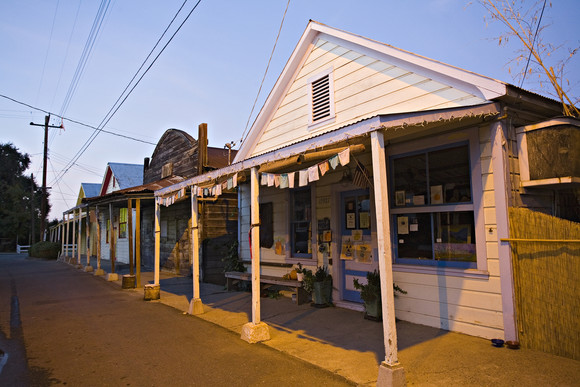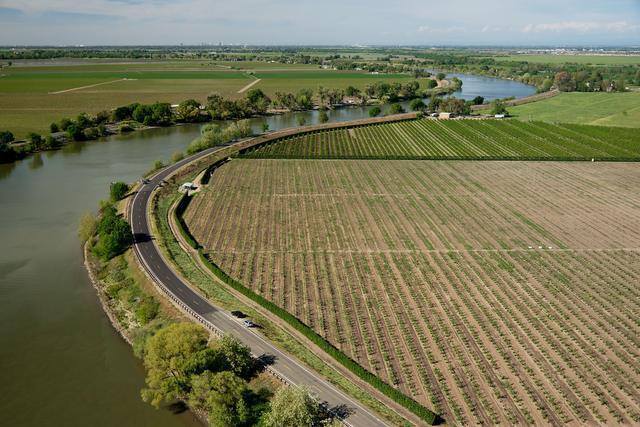|
Thanks for signing up to receive updates on how the National Historic Preservation Act (NHPA) can help protect the Sacramento-San Joaquin Delta from the impacts of constructing the Department of Water Resources’ (DWR) proposed Delta tunnel.
In this first update, we introduce the National Historic Preservation Act, suggest that the Delta’s culturally significant landscape deserves the NHPA’s protection, and outline next steps in protecting the Delta through historic preservation laws. Our goal is to share updates at least every other month with news about progress in using the NHPA to address the potential impacts of the proposed tunnel’s construction. We will also highlight ways you can get involved.
 The National Historic Preservation Act’s Section 106 can protect a historic district like Locke.
What is the National Historic Preservation Act?
Congress passed the NHPA in 1966 following several prominent controversies about federally supported projects that would `have damaged well-loved historic treasures. The law created a national registry of historic places to identify buildings, other structures, districts, and objects significant in American history, architecture, archaeology, or culture. Examples of properties in and near the Delta that are on the national register include Antioch’s Shannon-Williamson Ranch, the old Terminous packing station’s culling chute, now part of the Jellystone Park resort at Tower Park, an archaeological site at State Parks’ Delta Meadows property at Locke, Sacramento’s Tower Bridge, and historic neighborhoods in Isleton, Walnut Grove and Locke.
NHPA’s Section 106 requires a federal agency funding or permitting a project to consider the project’s effects on properties that are included or eligible for inclusion in the National Register of Historic Places. Eligibility rests on whether the property is significant, is 50 or more years old, and has integrity (e.g., has not been so altered that it no longer conveys its historic significance). A historic property need not be formally listed in the National Register to be considered under the Section 106 process. In the case of DWR’s proposed Delta tunnel, the U.S. Army Corps of Engineers (Corps) must carry out Section 106 when it considers permits for the tunnel.
A Culturally Significant Landscape
We believe areas of the Delta potentially affected by the proposed tunnel should be evaluated collectively as a significant cultural landscape. As defined by guidance for the NHPA, a cultural landscape is a geographic area, including both cultural and natural resources and the wildlife or domestic animals therein, associated with a historic event, activity, or person, or that exhibits other cultural or aesthetic values. The Delta is what is called a “historic vernacular landscape” that has evolved through use by the people whose activities or occupancy shaped it. Examples provided by the guidance fit the Delta areas potentially affected by the project: rural villages; agricultural landscapes such as farms and ranches, and landscapes encompassing linear resources including transportation systems, such as the Sacramento River or the River Road. A district of historic farms along a river may be an example of a significant cultural landscape, the guidance notes. Scenic highways such as Highway 160 are another example of a culturally significant landscape.
 A historic farm may be eligible for protection under the National Historic Preservation Act’s Section 106 even if it has no buildings.
Who Else is Involved?
In carrying out Section 106, the Corps must consult with the State Historic Preservation Office (unit within California State Parks) and affected Indian tribes. The Corps has also accepted the Delta Protection Commission and Sacramento, Yolo, San Joaquin, and Contra Costa counties as additional consulting parties in its Section 106 review.
As consulting parties, the Delta Protection Commission and the counties have expanded opportunities to advise the Corps on the scope of the area where the tunnel project may affect historic properties, the project’s potential adverse effects, measures that should be considered to avoid or reduce that harm, and, ultimately, the agreement the Corps may reach with the state, affected tribes, and potentially other consulting parties, to implement those measures included in the Corps’ approval. Consulting parties have expanded opportunities to share their views, receive and review pertinent information, offer ideas, and consider possible solutions together with the federal agency and other consulting parties. They cannot, however, block the project or use the Section 106 process to address issues such as the tunnel’s impacts on water resources that are not relevant to protecting historic properties.
What are the Next Steps?
To successfully complete the Section 106 review, the Corps must do the following:
- gather information to decide which properties in the area that may be affected by the tunnel project are listed, or are eligible for listing, in the National Register of Historic Places (referred to as “historic properties”);
- determine how those historic properties might be affected;
- explore measures to avoid or reduce harm (“adverse effect”) to those historic properties; and
- reach agreement with the State Historic Preservation Office and other consulting parties to resolve any adverse effects.
The Corps has said they hope to recommend a schedule for these steps in the next few months. One important milestone will be release of the project’s environmental impact report/ statement, which is expected this spring. By law, these reports must address effects on historic and cultural resources. We will keep you informed through this newsletter of key publications, schedules, and how you can get involved.
How Can I Help?
The involvement of people who care about the Delta’s cultural and historic resources will be key to protecting these assets. A first step you can take now is to share this newsletter with Delta historians, community groups, and others who are knowledgeable about Delta history and care about our region’s future. They can add themselves to the newsletter’s distribution list by signing up online.
For More Information
Learn more about the National Historic Preservation Act and its Section 106.
|